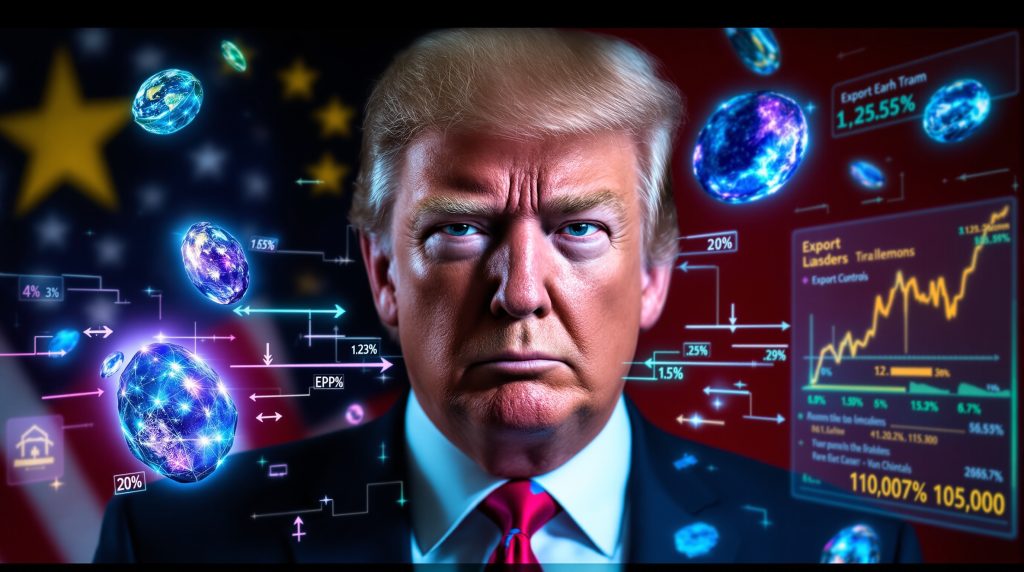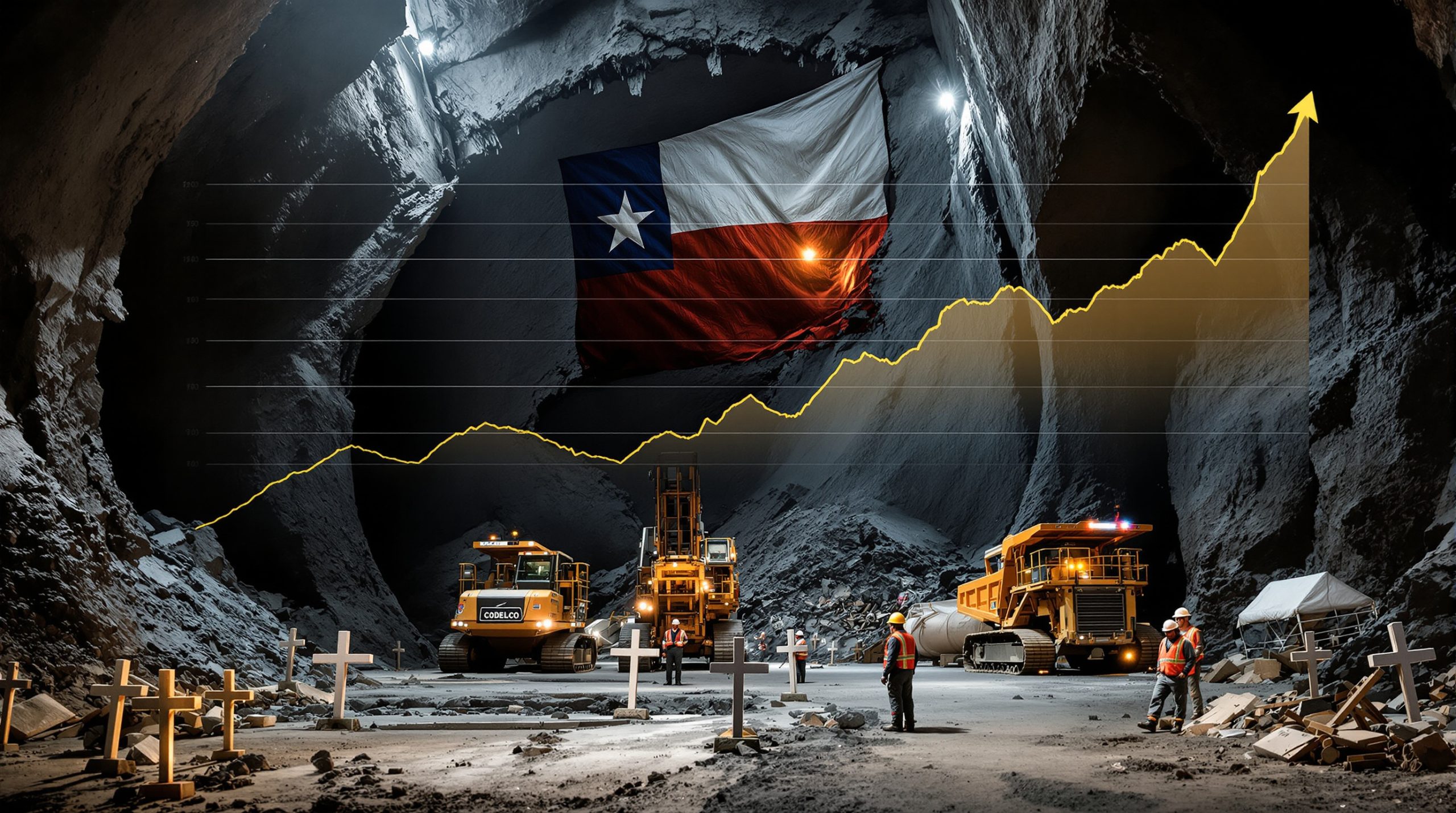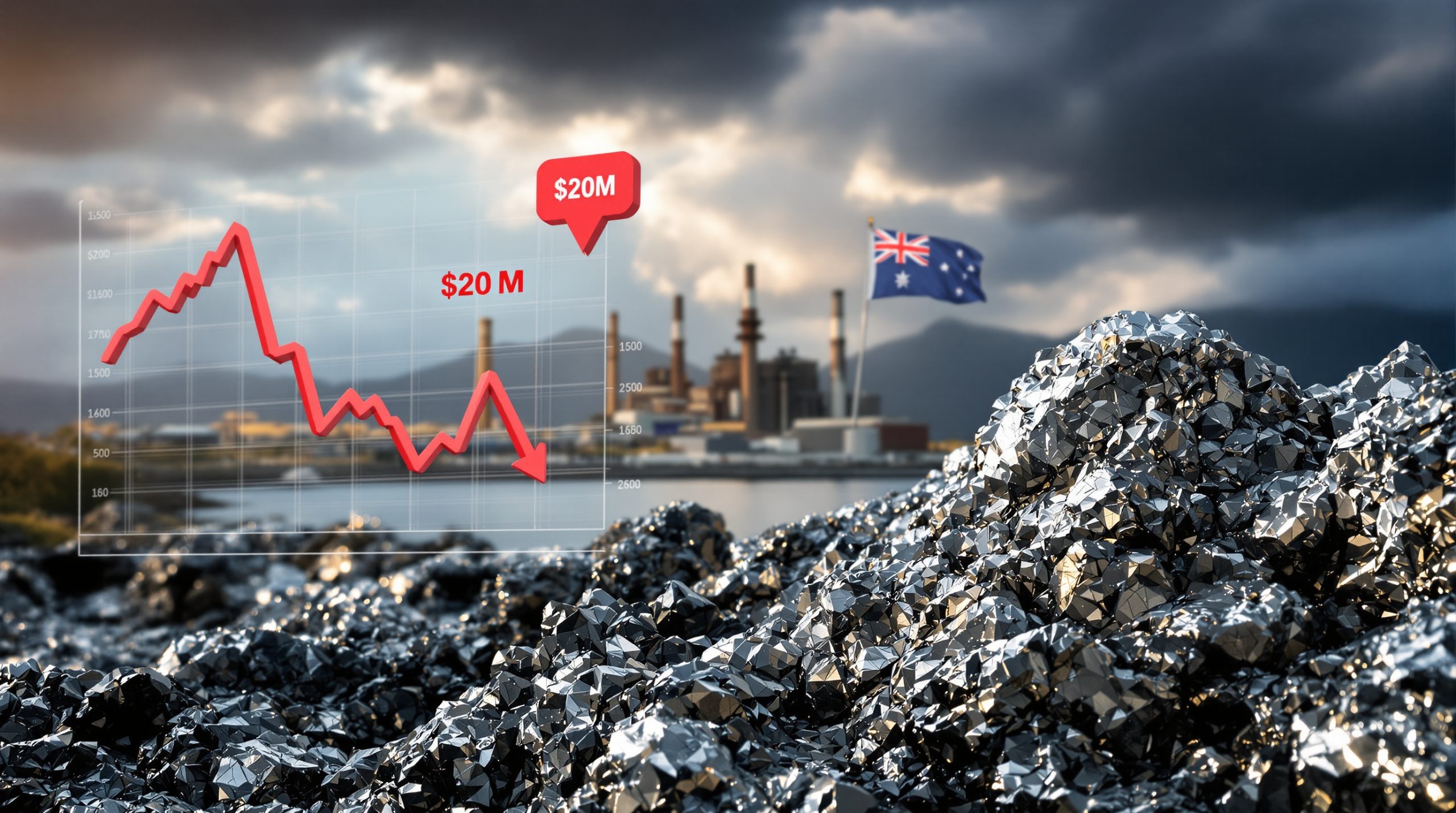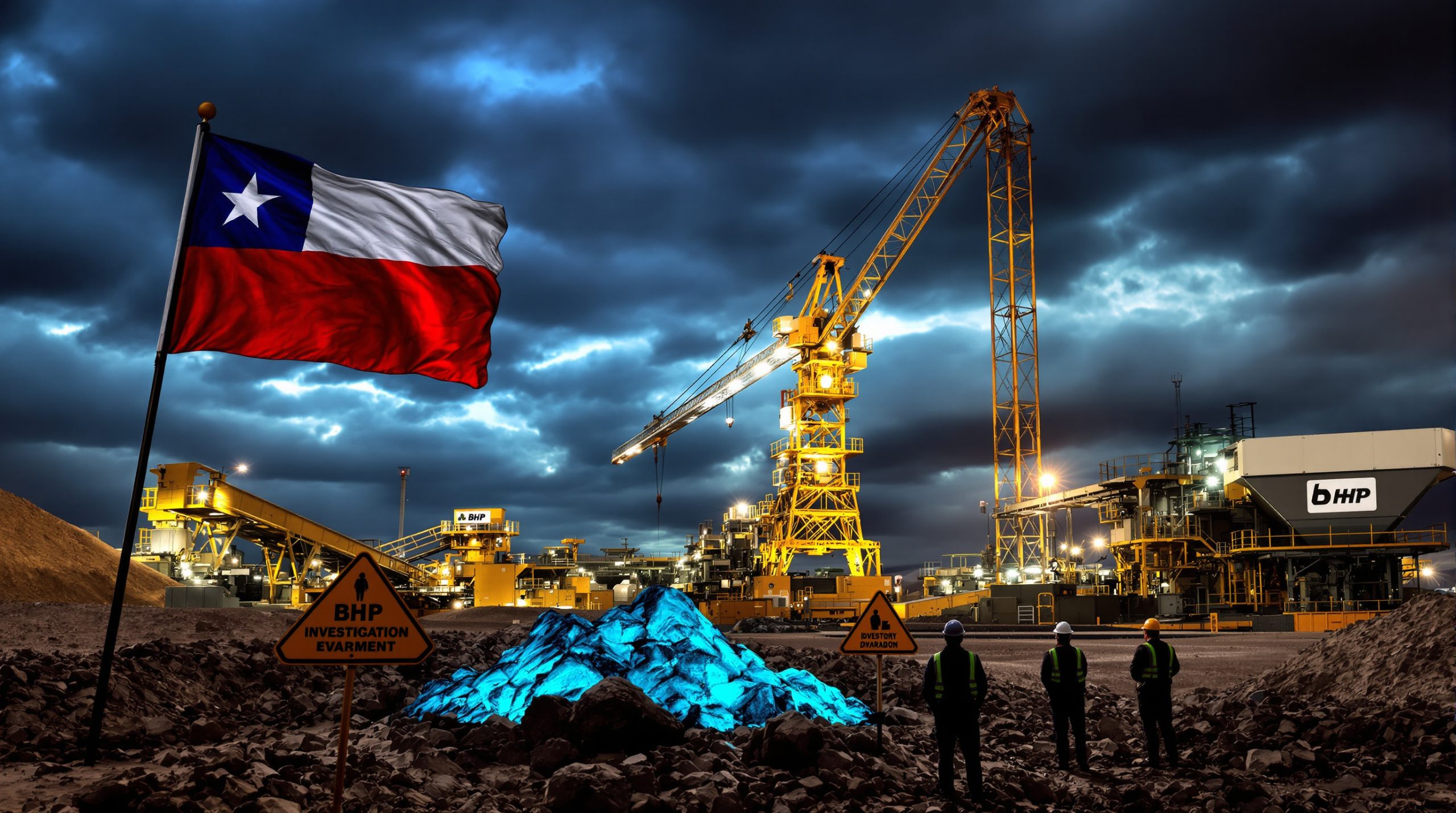Trump's Tariff Threat: Escalating Trade Tensions Over Rare Earth Controls
China's latest move to tighten control over rare earth exports has triggered significant international tension, particularly with the United States. The new restrictions, which took effect on October 9, 2025, require export licenses for products containing even trace amounts of Chinese-sourced rare earth elements—regardless of where the final product was manufactured.
This strategic decision targets medium and heavy rare earths critical to high-tech manufacturing, including scandium, yttrium, and several lanthanides essential for advanced technologies. The policy represents a calculated leverage of China's dominant position in the rare earth supply chain, where it accounts for approximately 70% of global rare earth mine production according to the U.S. Geological Survey.
Why Has Trump Threatened "Massive" Tariffs Against China?
President Donald Trump responded swiftly to China's export controls, characterizing them as "very hostile" trade behavior. In a statement posted on his Truth Social platform, Trump threatened a "massive increase" in tariffs on Chinese imports, escalating beyond the current 30% rate.
Trump indicated he saw "no reason" to meet with President Xi at the upcoming Asia-Pacific Economic Cooperation summit due to China's actions regarding rare earth exports.
The announcement sent U.S. stock markets tumbling, with major indices dropping sharply as investors processed the implications of renewed US-China trade impact between the world's two largest economies.
This latest confrontation follows a pattern established during Trump's first administration (2017-2021), when tariffs were imposed on approximately $370 billion worth of Chinese imports, with rates ranging from 7.5% to 25% according to the Peterson Institute for International Economics.
What Are Rare Earth Elements and Why Do They Matter?
Strategic Importance of Rare Earth Minerals
Rare earth elements comprise 17 metallic elements with unique properties that make them indispensable for modern technology. Despite their name, most rare earths aren't particularly rare in the Earth's crust, but economically viable deposits are uncommon and processing them is complex and environmentally challenging.
These elements serve as critical components in:
- Advanced semiconductor manufacturing
- Electric vehicle motors and batteries
- Wind turbine generators
- Military defense systems
- Aerospace technologies
- Medical imaging equipment
- Smartphone components
The U.S. Department of Defense notes in its Industrial Capabilities Report (2022) that a single F-35 Joint Strike Fighter contains approximately 920 pounds of rare earth materials, highlighting their critical importance to national security.
China's Rare Earth Dominance Explained
China has strategically positioned itself as the dominant player in the global rare earth supply chain:
| Aspect of Rare Earth Supply Chain | China's Global Share |
|---|---|
| Mining production | Approximately 70% |
| Processing capacity | 85-90% |
| High-performance magnets | Approximately 90% |
This concentration of control gives China significant leverage in trade negotiations and geopolitical positioning. The country has spent decades developing its rare earth industry while other nations allowed their domestic capabilities to atrophy.
According to research published in Resources Policy (Volume 74, 2021), "China's development of rare earth production was a deliberate industrial policy spanning decades, combining resource nationalism with strategic subsidy programs that enabled Chinese producers to undercut international competitors."
The U.S. Geological Survey data demonstrates this evolution clearly:
- 1990: China produced approximately 27% of global rare earths
- 2000: China's share increased to approximately 88%
- 2010: China's share peaked at approximately 97%
- 2023: China produced approximately 70% (as other countries increased production)
How Would New Tariffs Impact Global Supply Chains?
Potential Economic Ripple Effects
Any significant increase in tariffs on Chinese goods would create widespread disruptions across global supply chains, particularly for industries dependent on rare earth elements. The impacts would likely include:
- Higher production costs for electronics manufacturers
- Price increases for consumer technology products
- Accelerated efforts to develop rare earth sources outside China
- Potential shortages of critical components for defense applications
- Increased manufacturing costs for renewable energy technologies
Research by economists from the Federal Reserve and Princeton University found that the 2018-2019 U.S.-China tariffs resulted in nearly complete pass-through to U.S. consumer prices (95-100%) and an annual cost of approximately $1,277 per U.S. household, according to a study published in the Quarterly Journal of Economics (2020).
Industries Most Vulnerable to Disruption
Several sectors face particular vulnerability to rare earth supply disruptions:
-
Defense contractors: Military systems rely heavily on rare earth components for precision guidance, radar, and communications. The Congressional Research Service reports that Virginia-class submarines use approximately 9,200 pounds of rare earth permanent magnets (March 2023).
-
Electric vehicle manufacturers: EV motors typically require neodymium-based permanent magnets containing 1-2 kg of rare earth materials per vehicle according to the International Energy Agency's Global EV Outlook 2023.
-
Semiconductor industry: Advanced chip manufacturing depends on rare earth elements for polishing and performance.
-
Renewable energy sector: Wind turbines use large quantities of rare earth elements in their generators, with large offshore turbines containing up to 600 kg according to the European Raw Materials Alliance (2023).
According to Consumer Technology Association analysis (2019), a 25% tariff on rare earth imports could add $10-25 to consumer electronics through supply chain amplification effects, despite smartphones containing only approximately $1-2 worth of rare earth materials.
What Is China's Strategic Calculus Behind the Export Controls?
China's decision to implement stricter rare earth export controls appears to serve multiple strategic objectives:
-
Economic leverage: By controlling critical materials, China gains negotiating power in broader trade discussions.
-
Technology competition: Restricting access to rare earths could slow technological advancement in competing nations.
-
Domestic industry protection: The policy helps ensure Chinese manufacturers have preferential access to these critical resources.
-
Response to previous U.S. actions: The move may be partially retaliatory against earlier U.S. semiconductor export restrictions.
-
Supply chain dominance: Reinforcing China's position as the essential link in global high-tech manufacturing.
This approach follows historical precedent. During the 2010-2011 Senkaku/Diaoyu Islands dispute, China reduced rare earth export quotas, causing prices to surge 300-700% depending on the element, according to Financial Times reporting from 2011.
The Center for Strategic and International Studies noted in "Chinese Perspectives on Rare Earths" (April 2021): "Chinese policy documents explicitly reference rare earths as strategic resources for maintaining technological advantage in competition with the United States and other advanced economies."
How Have Previous Trade Tensions Affected U.S.-China Relations?
The current dispute over rare earths represents the latest chapter in increasingly complex U.S.-China trade relations. Earlier trade tensions have resulted in:
- Shifting manufacturing bases away from China to countries like Vietnam, Malaysia, and Mexico
- Increased domestic investment in critical industries by both nations
- Heightened economic nationalism and protectionist policies
- Volatility in global financial markets
- Accelerated "decoupling" of technology ecosystems
According to Federal Reserve Economic Data (FRED), the previous trade war had measurable impacts on bilateral trade:
- U.S. imports from China fell from $539 billion (2018) to $435 billion (2020)
- U.S. exports to China fell from $120 billion (2018) to $125 billion (2020)
- U.S.-China trade deficit declined from $419 billion (2018) to $310 billion (2020)
The American Chamber of Commerce in Shanghai's 2021 China Business Report found that 70% of surveyed companies reported Trump's tariff implications negatively impacted their business, and 33% were moving or considering moving production out of China, with Vietnam, Mexico, and Malaysia as top alternative locations.
What Options Does the U.S. Have to Reduce Rare Earth Dependency?
Domestic Production Initiatives
The United States has several potential strategies to reduce its vulnerability to rare earth supply disruptions:
-
Reopening domestic mines: The Mountain Pass mine in California, operated by MP Materials Corp, has resumed operations after previous closures. It currently produces approximately 15% of global rare earth output (approximately 38,000 metric tons per year) according to U.S. Geological Survey data.
-
Processing capacity development: MP Materials has announced a $700 million investment to build U.S. processing facilities with a completion target of late 2025, addressing the current limitation where 100% of concentrated rare earths from Mountain Pass are sent to China for processing.
-
Research into alternatives: Materials science researchers are working to develop substitutes that reduce or eliminate the need for certain rare earth elements. The U.S. Department of Energy's ARPA-E program reports that iron-nitride magnets have achieved 80% of neodymium magnet performance in laboratory settings.
-
Strategic reserves: Building stockpiles of critical rare earth materials to buffer against supply disruptions.
International Partnerships
The U.S. has also been pursuing international collaborations to diversify rare earth supply chains:
-
Partnerships with Australia, where Lynas Corporation operates the Mount Weld mine in Western Australia, currently producing approximately 10% of global rare earth output and constructing a $500 million facility in Texas for heavy rare earth processing.
-
Cooperation with Canada on mining and processing initiatives.
-
Exploration of opportunities in Brazil, Vietnam, and other nations with untapped reserves. Brazil holds approximately 21 million metric tons of reserves (16% of global total) according to the U.S. Geological Survey.
-
Technology sharing agreements to improve extraction and processing efficiency.
The U.S. government has committed substantial funding to these efforts, including $35 million from the Defense Production Act Title III for rare earth processing (2020), $140 million from the Bipartisan Infrastructure Law for rare earth demonstration facilities (2022), and additional support through the Inflation Reduction Act. Additionally, Trump's administration has previously issued a critical minerals order to address these supply concerns.
How Might This Dispute Evolve in the Coming Months?
Potential Scenarios and Outcomes
Several possible trajectories exist for the current trade dispute:
-
Negotiated resolution: Both sides could reach a compromise that eases rare earth restrictions in exchange for tariff reductions.
-
Escalating trade war: The conflict could expand to include additional sectors and higher tariffs from both sides.
-
Supply chain restructuring: Accelerated efforts to create parallel supply chains that bypass Chinese rare earth processing.
-
Technological adaptation: Increased investment in alternatives to rare earth-dependent technologies.
-
Multilateral pressure: The U.S. could coordinate with allies to apply collective pressure on China regarding rare earth access.
Historical precedent suggests some resolution may emerge. Following China's 2010 export quota reductions, prices normalized within 18-24 months as alternative production ramped up and some industries developed substitution technologies. China eventually adjusted its policy in response to a World Trade Organization challenge.
What Are the Implications for Global Technology Development?
The rare earth dispute highlights the complex interdependencies in global technology supply chains. As nations compete for technological supremacy, control over critical materials becomes increasingly strategic.
Long-term implications may include:
- Higher costs for advanced technology development
- Slower deployment of clean energy technologies
- Increased emphasis on recycling and material recovery
- Greater investment in synthetic alternatives to rare earth elements
- More regionalized technology ecosystems with reduced global integration
According to the International Energy Agency's "Energy Technology Perspectives 2023" report, the clean energy transition alone could require a 3-6x increase in rare earth demand by 2040, with electric vehicle production potentially requiring 4x current neodymium and dysprosium supply.
Current recycling rates for rare earth elements remain below 1% globally according to the United Nations Environment Programme's "Metal Recycling Report" (2022), though theoretical recycling potential could meet 20-25% of demand by 2040 if infrastructure is developed.
How Should Investors and Businesses Respond?
Strategic Considerations for Market Participants
For businesses and investors navigating this uncertain landscape:
- Supply chain diversification: Reducing dependency on single-source components
- Inventory management: Building strategic reserves of critical components
- Alternative sourcing: Developing relationships with emerging rare earth producers
- Technology adaptation: Investing in research for rare earth alternatives
- Scenario planning: Preparing for multiple potential outcomes in the trade dispute
Companies should also consider the processing timeline for rare earths – typically 6-12 months from ore to separated oxides according to the U.S. Department of Energy – when developing contingency plans for potential supply disruptions.
Processing costs present another strategic consideration. While separation costs in China average approximately $3-5 per kilogram, estimated separation costs in the U.S. and Europe range from $8-15 per kilogram due to higher environmental standards and labor costs, according to Argonne National Laboratory's "Rare Earth Elements Supply Chain Analysis" (2022).
FAQs About the Rare Earth Trade Dispute
What specific rare earth elements are most critical to modern technology?
The most strategically important rare earth elements include:
-
Neodymium and praseodymium: Essential for powerful permanent magnets used in electric motors, wind turbines, and hard disk drives
-
Dysprosium and terbium: Added to magnets to maintain performance at high temperatures
-
Europium and yttrium: Critical for phosphors used in displays and lighting
-
Lanthanum and cerium: Used in catalytic converters and petroleum refining
According to the International Union of Pure and Applied Chemistry (IUPAC), rare earth elements are classified into light rare earths (lanthanum through europium) and heavy rare earths (gadolinium through lutetium), plus scandium and yttrium.
How quickly could the U.S. develop alternative rare earth sources?
Developing new rare earth mining and processing capacity typically requires 5-10 years from discovery to production. While some projects are already underway, achieving significant independence from Chinese supply chains would likely take at least 3-5 years of accelerated investment and development.
The processing stages are particularly challenging, with separation technologies representing the most complex and costly step. According to the U.S. Department of Energy's Critical Materials Institute, rare earth separation involves multi-stage chemical processing with significant waste generation, specialized facilities requiring environmental controls, and processing costs that can exceed mining costs by 3-5 times.
Are there viable substitutes for rare earth elements in key technologies?
For some applications, alternatives exist but often with performance trade-offs:
-
Induction motors can replace permanent magnet motors in some electric vehicles, though with lower power density
-
Iron-nitride magnets show promise as alternatives to rare earth magnets
-
LED technology has reduced dependency on phosphor-based lighting
-
Nanotechnology approaches may eventually provide alternatives for some catalytic applications
The U.S. Environmental Protection Agency notes that rare earth mining and processing generates significant radioactive and toxic waste, including thorium and uranium byproducts, providing additional motivation for developing alternatives.
How might this dispute affect consumer technology prices?
If the trade conflict escalates, consumers could see price increases of 5-15% on electronics and other high-tech products that rely on rare earth components. The impact would vary by product category, with items containing many specialized components facing the largest increases.
Research from the previous trade war indicates that tariff costs are generally passed on to consumers. The Consumer Technology Association estimated in 2019 that a 25% tariff on rare earth imports could add $10-25 to consumer electronics through supply chain amplification effects, despite the relatively small direct cost of rare earth content in most devices.
Global Rare Earth Reserves Distribution
Understanding the global distribution of rare earth reserves provides important context for the current dispute:
According to the U.S. Geological Survey Mineral Commodity Summaries 2024, global rare earth reserves are estimated at 130 million metric tons, distributed as follows:
- China: 44 million metric tons (34% of global)
- Vietnam: 22 million metric tons (17% of global)
- Brazil: 21 million metric tons (16% of global)
- Russia: 12 million metric tons (9% of global)
- India: 6.9 million metric tons (5.3% of global)
- Australia: 4.1 million metric tons (3.2% of global)
- United States: 2.3 million metric tons (1.8% of global)
- Other countries: 17.7 million metric tons (13.7% of global)
This distribution highlights that while China controls the largest share of reserves, significant alternative sources exist if the necessary mining and processing infrastructure can be developed.
Future Outlook and Supply Chain Resilience
The current trade tensions over rare earth elements underscore the importance of supply chain resilience for critical materials. As global demand for advanced technologies continues to grow, with the rare earth elements market valued at approximately $8.2 billion in 2023 and expected to reach $15.3 billion by 2030 according to Mordor Intelligence, developing diverse and reliable supply chains will become increasingly important.
For businesses and policymakers alike, the challenge will be balancing short-term economic considerations with long-term strategic investments in alternative sources, processing capabilities, recycling infrastructure, and technological innovation. Furthermore, both the U.S. and European Union have been developing a critical minerals strategy to reduce dependence on Chinese supply chains, while the EU has recently established a European CRM facility to secure their own supply lines.
The outcome of this latest trade dispute will likely shape global technology supply chains for years to come, influencing everything from defense capabilities to renewable energy deployment and consumer electronics development.
Want to Discover the Next Major ASX Mineral Discovery?
Stay ahead of the market with Discovery Alert's proprietary Discovery IQ model, which instantly notifies investors of significant ASX mineral discoveries and transforms complex data into actionable insights. Visit the Discovery Alert discoveries page to understand how major mineral discoveries can lead to substantial returns and begin your 30-day free trial today.




